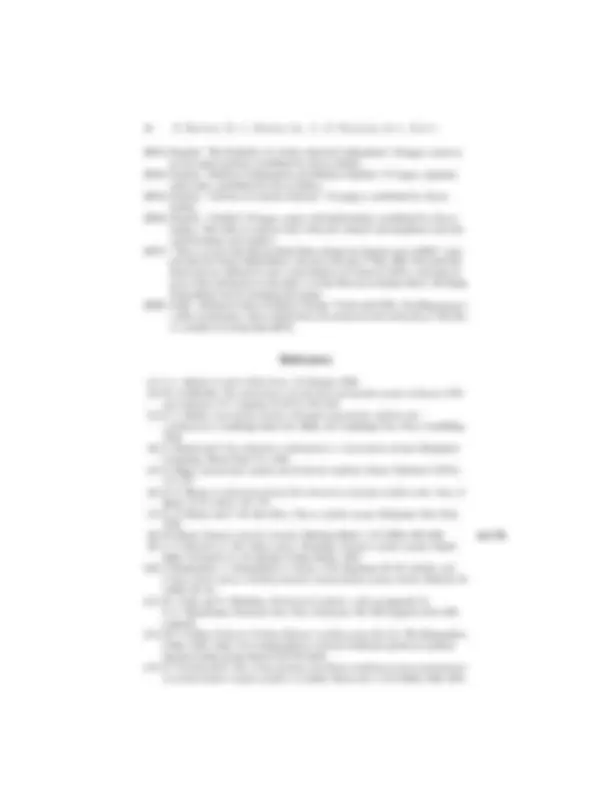























Study with the several resources on Docsity

Earn points by helping other students or get them with a premium plan


Prepare for your exams
Study with the several resources on Docsity

Earn points to download
Earn points by helping other students or get them with a premium plan
Community
Ask the community for help and clear up your study doubts
Discover the best universities in your country according to Docsity users
Free resources
Download our free guides on studying techniques, anxiety management strategies, and thesis advice from Docsity tutors
Robert Griess is grateful to the University of Michigan, ... Donald Higman's beginnings were in group theory and representation theory,.
Typology: Exams
1 / 29

This page cannot be seen from the preview
Don't miss anything!






















Michigan Math. J. 58 (2009)
bio
Donald Gordon Higman (born 20 September 1928 in Vancouver, B.C., Canada)—
AQ -
an architect of important theories in finite groups, representation theory, algebraic combinatorics, and geometry and a longtime faculty member at the University of Michigan (1960–1998)—died after a long illness on 13 February 2006. Don left a significant legacy of mathematical work and personal impact on many mathematicians. A committee was formed in 2006 to work with the Michi- gan Mathematical Journal and create a memorial. The contributors have some mathematical closeness to Don. Several of Don’s fifteen doctoral students are in- cluded in this group. The breadth of topics and quality of the writing is impressive. For example, the article of Broué is especially direct in examining the impact of one of Higman’s basic results in representation theory (the “ Higman criterion”). Don Higman was a serious intellectual who had the manner of a kind uncle or concerned friend. He worked broadly in algebra and combinatorics. He thought deeply about the ideas in his mathematical sphere, and his style was to seek the essence of a theory. His work had great influence on future developments. This is exemplified by one of his theorems in permutation groups, as related by Peter Neumann: Don’s “fundamental observation that a permutation group is primitive if and only if all its nontrivial orbital graphs are connected changed the character of permutation group theory. It’s a simple thing, but it introduces a point of view that allowed lovely simplifications and extensions of the proofs of many classical theorems due to Jordan, Manning, and Wielandt.” Len Scott relates Don’s reaction to a John Thompson lecture, around 1968, at a conference at the University of Illinois. This was not long after the discovery of the Higman–Sims sporadic simple group. Thompson expressed agreement with Jacques Tits’s “heliocentric view of the universe, with the general linear group as the sun, and these sporadic groups as just asteroids.” Len happened to be on the same elevator with Don, shortly after the lecture, when one of the participants asked Don what he thought of the heliocentric model. Don’s reply was, “Well, it hurts your eyes to look at the sun all the time.” The elevator passengers had a good laugh, and it really was a marvelous line. But, reflecting further, not only can we see a part of Don’s personality and humor here, but also some of his identity as a mathematician and even some of his place in mathematical history. 1
2 E. Ban na i , R. L. G r i e s s , J r. , C. E. P r a e g e r , & L. Sc o t t
The decade that followed saw a dramatically changed picture of the finite simple groups. At the beginning of this period, there were a number of well-defined infi- nite families of finite simple groups that contained all known finite simple groups, with only finitely many exceptions. At that time, these finitely many finite sim- ple groups that did not fit were called “sporadic” (group theorists were unsure as to whether more infinite families might be found). The advance of the classifica- tion during that period suggested that there were, indeed, no more infinite families and there were only finitely many sporadic groups. Nevertheless, during the same period, many new sporadic groups were discovered, bringing the number of spo- radics to 26 by 1975. In addition, these discoveries inspired new algebraic con- structions and conjectures, as well as striking empirical observations, that starting in the late 1970s linked sporadic group theory with other areas of mathematics and physics (this body of phenomenon is generally called “moonshine”). These sporadic groups may well have as much impact outside group theory as within it. Don Higman’s independent and skeptical opinions seem to have been vindicated by the end of the 1970s.
Acknowledgments. The editors thank the following individuals for their cor- respondence or help with writing this biography, including contributions of pho- tos and unpublished writing and tables: Jonathan Alperin, Michael Aschbacher, Rosemary Bailey, Francis Buekenhout, Peter Cameron, Charles Curtis, David Foulser, George Glauberman, David Gluck, James A. (Sandy) Green, Karl Gru- enberg, Willem Haemers, Jonathan Hall, Betty Higman, Sylvia Hobart, Alexan- der Ivanov, Misha Klin, Ching-Hung Lam, Robert Liebler, Hirosi Nagao, Peter Neumann, Manley Perkel, Geoffrey Robinson, Betty Salzberg, Alyssa Sankey, Ernie Shult, Charles Sims, Don Taylor, John Thompson, Andrew Vince, and Paul- Hermann Zieschang. Robert Griess is grateful to the University of Michigan, National Cheng Kung University, Zhejiang University, and the National Science Foundation for finan- cial support during the writing of this biography. Cheryl Praeger is grateful for the support of a Federation Fellowship of the Australian Research Council. Len Scott thanks the National Science Foundation for its support during the writing of this biography.
Donald Higman’s beginnings were in group theory and representation theory, clearly reflecting the interests of his Ph.D. advisor Reinhold Baer. Don’s focal subgroup theorem is logically at the center of basic local group theory (the study of finite groups by normalizers of their nonidentity p-subgroups, where p is a prime). The focal subgroup theorem has been desribed by Jon Alperin [1] as “a basic concept in the theory of transfer”. Alperin also writes: “[Don] introduced relatively projective modules, which are the key tool for Green’s whole theory of modules, and contributed to relative homological algebra. He proved, as a result, that if F is a field of prime characteristic p and G is a finite group then there are
4 E. Ban na i , R. L. G r i e s s , J r. , C. E. P r a e g e r , & L. Sc o t t
Don Higman attended college at the University of British Columbia. Betty Hig- man explains that “there was a woman at U.B.C., Celia Kreiger, who urged [Don] to continue his interest in math and apply to grad school. She might have been in- strumental in suggesting Reinhold Baer and the University of Illinois. Then there was Hans Zassenhaus [with whom he worked] at McGill.” A group photo of a Canadian summer mathematics program, probably 1951 or 1952, includes Don Higman and Hans Zassenhaus. After Don’s doctorate in 1952, he spent two years as a National Research Council Fellow at McGill University, then two years on the faculty of Montana State University. Thereafter, he accepted an assistant pro- fessorship at the University of Michigan and became professor in 1960. The main mathematical influences on Donald Higman seemed to be his advisor Reinhold Baer and algebraist Jack E. McLaughlin, a colleague at the University of Michigan who was older by a few years. There was another significant con- tact during graduate school: Michio Suzuki and Don Higman overlapped at the University of Illinois for about a year. It is clear from their later work that mu- tual influence was likely. Both studied with Reinhold Baer. Coincidentally, Eiichi Bannai, an editor of this special issue, thought of Michio Suzuki as a mathemati- cal father and Don Higman as a kindly mathematical uncle. McLaughlin and Higman authored three joint articles [H10; H13; H16] and maintained an ongoing dialogue about mathematics for decades. Their common interests included general algebra, group theory, representation theory, and coho- mology. In 1968, McLaughlin discovered and constructed a sporadic simple group using the rank-3 theory of Higman and the embedding of PSL(3, 4) in PSU(4, 3) dis- covered by H. H. Mitchell [40]. See the book of Brauer and Sah [7] for how finite simple group theory looked in the late 1960s.
Don Higman’s focal subgroup theorem is an insightful result about intersections of normal subgroups of a finite group with a Sylow p-subgroup. In early work on homological aspects of group representation theory, Don established the impor- tant concept of a relatively projective module and gave a criterion, which bears his name, for relative projectivity. Higman proved that the finiteness of the num- ber of isomorphism types of indecomposable modules in characteristic p for a finite group G is equivalent to cyclicity of the Sylow p-group of G. This is a basic result in the theory of modules for group algebras. He did some of the earliest computations of degree-1 cohomology of classical groups as part of his study of flag-transitive groups.
4.1. Focal Subgroup Theorem
Higman’s theory of the focal subgroup of a Sylow subgroup was a basic tool in local analysis in finite group theory. It could be viewed as a contribution along the
The Mathematics of Donald Gordon Higman 5
lines of Burnside, Frobenius, Grün, et al. to the determination of quotients that are p-groups (p is a prime number). It turns out that the focal subgroup theory is log- ically at the center of p-local group theory. Consider the recent words of George Glauberman: “When I was preparing some lectures on local analysis [22], I had to omit the details of the definition of the transfer mapping and all proofs using the explicit definition. I found that I could prove all the applications of transfer that I needed by assuming without proof only two applications: the focal subgroup the- orem and the fact that for a Sylow subgroup S of a group G, S ∩ Z(G) ∩ G′^ = S ′^ ∩ Z(G).” (The priming here indicates commutator subgroup.) In the focal subgroup paper [H3, p. 496], there is a final remark about a com- munication with Brauer who reports overlaps with results from his paper on the characterization of characters [6]. Higman states that those results follow from the focal subgroup theory. David Gluck brought to our attention the footnotes in Section 5 of [6], which indicate that Richard Brauer essentially agreed with Don’s assertions. It seemed to Gluck that Brauer was impressed with Higman, and this may have influenced Don’s success in getting a job at the University of Michigan (for Brauer had been a member of the University of Michigan faculty during 1948–1951 before moving to Harvard). There seemed to be logical connec- tions between the characterization of characters and the focal subgroup theorem that are not yet fully explored. The focal subgroup definition bears strong resemblance to the stable cocycle condition described by Cartan and Eilenberg [11], which (as Alperin has sug- gested) could be viewed as a way to extend the focal subgroup theory to higher cohomology groups. We have no evidence that Higman foresaw these connections.
4.2. Representation Theory
Donald Higman wrote eight papers on representation theory over a period of seven years (1954–1960). The most influential paper was the first [H5], in which he in- troduced the notions of a relatively projective (or injective) module for the group algebra of a finite group and gave the famous criterion for relative projectivity that bears his name, Higman’s criterion. James A. (Sandy) Green writes [23]: “I am very sorry to learn that Don has died. Mathematically I owe him for the idea of rel- ative projectivity of modules over finite groups. This was the starting point of work I did on the ‘vertex’and ‘source’of an indecomposable kG-module (G finite group, k field of characteristic p > 0 ).” One of the first results of any kind on indecom- posable modules was Don’s paper [H6], which showed that having a cyclic Sylow p-subgroup was a necessary and sufficient condition for a group to have just finitely many isomorphism classes of indecomposable modules over a given field of char- acteristic p. The theory has come a long way since then, and some of its main con- tributors have written in this very volume. In particular, Michel Broué [8] discusses modern generalizations of Higman’s criterion, very much in the spirit of Don’s own generalization [H7] beyond group algebras. Michel writes in the introduction of [8]: “It must be noted that ways of generalizing Higman’s original criterion had been opened half a century ago by Higman himself ”. Again in a general algebraic context, rather than for group algebras alone, Don presented in [H9] a theory, in- dependently obtained by G. Hochschild [33], of relative homological algebra.
The Mathematics of Donald Gordon Higman 7
and Eilenberg. The adaptation of these ideas to the case of group algebras was done by Gaschütz in 1952, and extended to the notions of relative projective and injective modules by Higman in 1954. The main result obtained at this stage in the development was Higman’s theorem, published in 1954, that a group algebra of a finite group G over a field of characteristic p has finite representation type (that is, has at most a finite number of isomorphism classes of indecomposable mod- ules) if and only if the Sylow p-subgroups of G are cyclic. This result has been influential in the theory of integral representations of finite groups, in the repre- sentation theory of Hecke algebras, and in the modular representation theory of finite groups, up to the present time. Another important development was Green’s theory of vertices and sources of indecomposable modules, which remains a cen- tral topic in the modular representation theory of finite groups, and is based on Higman’s theory of relative projective modules. One of the chapters of our book was largely devoted to Higman’s work in this area.”
5.1. ABA Groups and Rank-2 Geometry Characterization The “ABA groups” paper [H13] in1961with University of Michigan colleague Jack McLaughlin arose from an effort to characterize low-rank finite simple groups and their geometries. Apart from the famous theorem that a finite 2-transitive projec- tive plane is Desarguesian, the paper contains a number of fundamental results that continue to have application in group theory and combinatorics. Shortly after it appeared, a result from the paper was used by Charles Curtis [14] to classify a family of finite Chevalley groups; and nearly thirty years after its publication, another of its results laid the basis for the classification [10] of flag-transitive lin- ear spaces, proving that such spaces have a point primitive automorphism group. The paper remains influential, being cited nearly twenty times in the last decade in publications on linear spaces and symmetric designs.
5.2. Rank-3 Permutation Groups Don Higman’s theory of rank-3 permutation groups was initiated in 1964 in his paper [H15], in which he studied their parameters, incidence matrices, and char- acter degrees. His approach was highly influential on the work of other group the- orists, not least because several sporadic simple groups were discovered as rank- groups—in particular, the Higman–Sims simple group discussed in Section 5.3. AQ - Also in his 1964 paper Higman gave a pair of design constructions that are now standard constructions for symmetric designs. His other papers on this theme fo- cused on characterizations proving, for example, that all rank-3 affine planes are translation planes. It is notable that Higman chose rank-3 groups as the topic for his invited lecture [H28] at the International Congress of Mathematicians in Nice in 1970.
8 E. Ban na i , R. L. G r i e s s , J r. , C. E. P r a e g e r , & L. Sc o t t
5.3. The Higman–Sims Graph and the Higman–Sims Sporadic Simple Group of Order 44,352,000 = 2 9 3 2 5 3 7 · 11
The discovery by Donald Higman and Charles Sims of the Higman–Sims simple group is legendary. According to Sims’s account in [30], Don and he had just heard Marshall Hall’s description, at the 1967 “Computational Problems in Abstract Al- gebra” conference in Oxford, of the construction of the Hall–Janko sporadic simple group as a rank-3 permutation group on 100 points. Higman and Sims examined closely a list of possible rank-3 parameters that Higman had compiled using his rank-3 theory, and their attention quickly focused on a possible rank-3 group with point stabilizer the Mathieu group M 22 or its automorphism group M 22. 2. In dis- cussion during an intermission in the formal conference dinner on the last day of the conference (2 September 1967), Higman and Sims realized that these groups had natural actions on both 22 points and 77 points. They continued their work on these actions after the dinner finished and eventually realized that they needed to construct a valency-22 graph on 100 vertices, now called the Higman–Sims graph. In the early hours of Sunday, 3 September 1967, using the uniqueness of the asso- ciated Witt design, they proved that the automorphism group of their graph was vertex-transitive and was a new simple group. We re-publish with permission the 2002 account by Charles Sims [30] of this famous story. “Prior to this conference, Don had been investigating rank-3 groups. He had discovered a number of conditions that the parameters [H57] of such a group have to satisfy and had used a computer to generate a list of parameters that satisfied all of his conditions. I was familiar with Don’s work.... “At the Oxford conference, Marshall Hall announced the construction of Janko’s second group. [This group is more correctly called the Hall–Janko group because AQ - both Hall and Janko discovered it independently; see [24; 27].] There is a long paper by Marshall in the conference proceedings that includes, among other things, a description of how this group was constructed. The group was given as a rank- group of degree 100 with subdegrees 1, 36, and 63. “After Marshall’s talk, Don and I discussed whether there might be other rank- 3 groups of degree 100. If it were not the case that we use the decimal system and that 100 = 10 2 , I am not sure we would have asked this question. “Don consulted his list of rank-3 parameters and found that the subdegrees 1, 18, 81 appeared on the list of degree 100. It did not take us long to realize that the wreath product of S 10 and Z 2 has a rank-3 representation (on the Cartesian product of two copies of {1,... , 10}) of degree 100 with these subdegrees. “Encouraged, we looked at the list again. There was one other set of subdegrees for a possible rank-3 group of degree 100, namely 1, 22, 77. The number 22 cer- tainly suggests that the stabilizer of a point should be M 22 or its automorphism group. (S 22 and A 22 don’t have representations of degree 77.) We did not imme- diately see how to construct such a group and agreed to continue our discussion later. “The conference dinner was held on the last day of the conference, Saturday, September 2. This dinner was quite formal. After the main part of the meal, the
10 E. Ban na i , R. L. G r i e s s , J r. , C. E. P r a e g e r , & L. Sc o t t
the association scheme, corresponding to the four choices for the structure of the blocks of [the design]. It is not known whether any of the four solutions are equiv- alent under some permutation of treatments.’ There is no further determination of isomorphisms or the automorphism group, nor mention of the groups of Mathieu or the work of Witt on Steiner systems.”
5.4. Strongly Regular Graphs and Association Schemes
Don’s original motivation for studying the combinatorics underlying permutation groups was purely group theoretic. For example, in his magnificent “intersection matrices” paper [H18] of 1967, Don proved his famous primitivity criterion for finite transitive permutation groups mentioned in the Introduction. In that same paper he introduced (what are now called) intersection arrays of finite distance- regular graphs from a group-theoretic perspective and began the study of permu- tation groups of maximal diameter. Gradually it was realized that rank-3 permuta- tion groups correspond to strongly regular graphs; that Don’s intersection matrices correspond to association schemes; and that permutation groups of maximal diam- eter correspond to distance-transitive graphs, a class of graphs studied intensively over the succeeding decades. The concept of a strongly regular graph already existed in the combinatorial literature, and association schemes (i.e., symmetric association schemes) were known in statistics and experimental design theory, in particular in the work of R. C. Bose and his school. It seems that these connections were not known to group theorists at the time of Don’s paper [H18]. Several years later in 1970, in an important paper [H26] with Hestenes, Don explored the connection between rank-3 groups and strongly reg- ular graphs, introducing and studying the adjacency algebras of such graphs and giving a combinatorial form of primitivity. The theories of strongly regular graphs and association schemes were given real mathematical depth by this fruitful en- counter with group theory. Moreover, it was natural for Don to study these objects also from the combina- torial viewpoint: in his 1970 paper [H26] he introduced the “4-vertex condition” on a graph, a combinatorial alternative to the group-theoretic rank-3 condition. He used this to obtain a new proof of a result of Seidel determining the strongly regular graphs with smallest eigenvalue − 2.
5.5. Coherent Configurations
One of Don’s most notable contributions in the area of combinatorics is his in- troduction of the concept of a coherent configuration in his 1970 paper [H23]. A coherent configuration is an axiomatization, in a purely combinatorial setting, of the structure of an arbitrary permutation group. It generalizes the notion of an as- sociation scheme, which may be regarded as a combinatorial axiomatization for a transitive permutation group. Don arrived at this general concept as soon as he was aware of the combinatorial interpretation of his early work on permutation groups. He developed the theory of coherent configurations in full generality: first in [H23] and in more polished form in other papers, most notably [H35], [H37], and his paper [H41] on coherent algebras in 1987. The main content of these
The Mathematics of Donald Gordon Higman 11
papers is a study of the algebraic conditions arising from association schemes and coherent configurations. Don studied the adjacency algebras (centralizer alge- bras) of these combinatorial structures, obtaining many important properties such as orthogonality relations, Schur relations, and Krein conditions. A major reason why Don studied the representation theory of association schemes and coherent configurations was to apply the algebraic conditions he obtained to the study of many geometric objects. In his 1974 paper [H32] he illustrated how the theory of coherent configurations could be applied by studying generalized poly- gons and, in particular, gave alternative proofs of the famous theorem of W. Feit and G. Higman and of the Krein condition (to be discussed shortly). These results, in turn, were applied in [H32] to prove the following theorem: If a generalized quadrangle or octagon has s + 1 points on each line and t + 1 lines through each point with t > 1, then s ≤ t 2. Don also applied his theory more generally to study, among other things, partial geometries, a concept related to that of a strongly reg- ular graph. Don Higman’s representation theory of coherent configurations is thorough and useful and is unequalled by any other author. On the other hand, he did not treat many concrete examples in his papers, leaving this to others such as [4] and [9] (for symmetric or commutative association schemes). The nonnegativity of the so-called Krein parameters is very important in the theory of association schemes—in particular, in the Delsarte theory of codes and designs in association schemes [4; 9; 19]. A version of this condition was first noticed in 1973 in the context of permutation groups by Leonard Scott and his col- league Charles Dunkl, translating from earlier work of Krein; see [44] and [45]. Using work of Schur dating even earlier than Krein’s work, Don (and indepen- dently N. Biggs [5]) proved the Krein condition in full generality in the context of association schemes. Don’s new approach to the development and exposition of the Krein condition theory has been most influential [13; 21; 29; 31]. Don often lectured on this to new audiences.
5.6. Geometric Applications of Coherent Configurations
Donald Higman’s research in the 1980s and 1990s focused mainly on the applica- tion of theories of association schemes and coherent configurations to geometry. Many of his later works may be characterized as follows. Using the algebraic properties of adjacency algebras of association schemes and coherent configura- tions, he determined their feasible parameter sets under various conditions. He then characterized the known examples, and for many of the other small param- eter sets he proved the nonexistence of examples. He was interested in a variety of geometric structures, especially those admitting interesting group actions. In particular, he studied special kinds of buildings (in the sense of Jacques Tits) as imprimitive association schemes. We discuss in what follows other notable geo- metric structures that he studied. A transitive permutation representation can be regarded as the induced repre- sentation of the identity representation of a subgoup H of G. A similar theory is available for the induced representation of a linear representation of a subgoup H of G. Don’s general theory of weights on coherent configurations (and association
The Mathematics of Donald Gordon Higman 13
In passing, we would like to mention the following two streams of similar ideas to study combinatorial objects from a group-theoretic viewpoint.
(1) Essentially the same concept as coherent configuration was studied in Rus- sia under the name of “cellular rings”, independently and simultaneously, as there was not much scientific communication between East and West at that time (see e.g. [50]). (2) The theory of Schur rings that was developed by Wielandt [51] and furthered by Tamaschke [49] also treats a connection between groups and combinatorics (note that the concept of a Schur ring falls somewhere between a permutation group and an association scheme). AQ -
5.7. Connections with Statistics, Topology, and Mathematical Physics
There are several connections that the work of Donald Higman makes outside al- gebra. Association schemes occur in statistics (this article mentions the work of Bose and Bailey). The thesis of Mesner [37] on Latin squares turned up a special set of graphs on 100 points, one of which is the Higman–Sims graph. François Jaeger constructed the spin model (in the sense of V. H. F. Jones) on the Higman– Sims graph, and it plays an important role in the theory of spin models (more broadly in topology and mathematical physics); see [28; 34].
Don Higman’s international engagement in the group theory and combinatorics communities made a strong impression on younger mathematicians. He made reg- ular visits to England, Holland, Belgium, Germany, Australia, Italy, and Japan, and he organized meetings in Oberwolfach starting with the “Die Geometrie der Grup- pen und die Gruppen der Geometrie under besondere Berücksichtigung endliche Strukturen” (18–23 May 1964).
6.1. Michael Aschbacher
“I went to graduate school to become a combinatorist, and wrote my thesis in de- sign theory. My approach was to study designs from the point of view of their automorphism groups, so I became interested in finite permutation groups, to the point that in my last year in graduate school I decided to work in finite group the- ory rather than combinatorics. “In one part of my thesis, I studied certain designs whose automorphism group was rank 3 on points of the design. Thus I was led to read Donald Higman’s fun- damental papers on rank-3 permutation groups, and rank-3 groups have remained one of my interests ever since. “In particular in one of my early papers [2], I showed that there is no Moore graph on 3250 vertices with a rank-3 group of automorphisms. This was moti- vated by Higman’s paper [H15], where in Section 6 he shows that in a rank-3 group with λ = 0 and μ = 1, k is 2, 3, 7, or 57, and he determines the possible groups in all but the last case, which he leaves open. In the graph-theoretic literature, the
14 E. Ban na i , R. L. G r i e s s , J r. , C. E. P r a e g e r , & L. Sc o t t
corresponding strongly regular graphs are called Moore graphs, and of course a Moore graph of valence 57 is on 3250 vertices. “A year later, reading Bernd Fischer’s wonderful preprint on groups generated by 3-transpositions, I decided to attempt to extend Fischer’s point of view to what I called ‘odd transpositions’. The base case in this analysis involves almost sim- ple groups G, and after handling some small degenerate cases, an extension of Fischer’s fundamental lemma shows that G acts as a rank-3 group on a certain system of imprimitivity for the action of G on its odd transpositions. Thus, once again, Higman’s theory of rank-3 groups became a central tool in my early work. “I probably first met Donald Higman at a meeting in Gainesville, Florida, in 1972, organized by Ernie Shult. However, my strongest early memories of Hig- man are from a two-week meeting in Japan in 1974 organized by Michio Suzuki. This was only my second trip abroad, and one of my favorites. A number of wives also took part, including my wife Pam. Both Donald and Graham Higman at- tended the meeting, and I recall Pam referring to them as “the Higmen”. As I recall the two were connected in our minds, not just because of their names, but because both had extremely luxuriant eyebrows.... “ He was an excellent mathematician who will be missed.”
6.2. R. A. Bailey
Rosemary Bailey relates three small anecdotes about Don, whom she—as did many of her fellow research students in Oxford—called DGH. “I started as a Ph.D. student at Oxford in October 1969, under the supervision of Graham Higman. In summer 1970 I attended the International Congress of Mathematicians in Nice. Of course, much of it was above my head at that stage. The talk that most impressed me was the one by DGH. I was even brave enough to go up and talk to him about it afterwards, and I remember him being very kind. “Some time in 1971, DGH visited Oxford for a few months. He gave a course of lectures called ‘Combinatorial Considerations about Permutation Groups’. At the time, not only was I working on permutation groups but Graham Higman had given us a series of advanced classes on strongly regular graphs, so we were well prepared. I was absolutely fascinated by DGH’s clear lectures. Well, I went away and became a statistician, but something must have stuck in my mind, because when I came back into association schemes via the original Bose–Nair approach I was able to put it all together, and this eventually led to my 2004 book [3] on as- sociation schemes. I mentioned these lectures of DGH’s in the Acknowledgments page to that book. “Most combinatorialists know what a t-design is, or at least what a 2-design is. Dan Hughes introduced this terminology into the literature. However, he says that it was DGH who suggested it to him: see pages 344–345 of [3].”
6.3. Eiichi Bannai
“I knew Donald G. Higman for many years, and I was mathematically very much influenced by him. This was at first through Suzuki, whom I viewed as a kind of
16 E. Ban na i , R. L. G r i e s s , J r. , C. E. P r a e g e r , & L. Sc o t t
regular graphs. The connection between strongly regular graphs and rank-3 per- mutation groups was well known by that time. I read many of Higman’s papers on rank-3 permutation groups, those related to classical geometries, and the one on intersection matrices for finite permutation groups. Although Higman’s earlier papers were in the context of finite permutation groups, its combinatorial aspects AQ - were evident. In early 1970s, I tried to follow Higman’s research direction in var- ious ways. Let me comment on some of these directions of Higman. “(i) (Small-rank subgroups of classical groups.) The first thing I tried in my re- search was to find (and classify) small-rank (in particular rank-2, i.e., 2-transitive) subgroups of classical groups, or of simple groups of Lie type. During that study, I determined rank-2 subgroups H of PSL(n, q), that is, 2-transitive permutation rep- resentations of PSL(n, q), by determining the candidates of possible irreducible characters χ that might possibly appear in 1GH ; I used Green’s theory of the char- acter theory of GL(n, q). Later, I realized that this approach is considerably sim- plified by using the work of Higman [H14] on flag-transitive subgroups, since it holds that χ must appear in 1GB if H is not flag transitive. (Here B is the Borel sub- group, i.e., the upper triangular subgroup.) Also, I was very much interested in the paper [H13], which, before the Tits general theorem on spherical buildings, char- acterized the group PSL(3, q) by essentially giving the classification of A 2 -type buildings (in the context of groups). This was used in many situations later by many authors. “(ii) (Rank-3 transitive extensions.) Another direction of my research was to try to find new simple groups: starting with a known group H, to find G that con- tains H as a rank-3 (or small-rank) subgroup. To be more precise, starting from a permutation group H, finding a transitive group G whose stabilizer of a point is isomorphic to H is called a transitive extension problem. The discovery of the Higman–Sims group was one such beautiful example. Various sporadic groups— AQ - such as Hall–Janko, McLaughlin, Suzuki, Rudvalis, and the Fischer groups—were discovered this way. I think I started this project too late, since it turned out that AQ - all were already discovered as a consequence of the classification of finite simple groups. “(iii) (Intersection matrices for finite permutation groups.) The paper I read most carefully was... ‘Intersection Matrices for Finite Permutation Groups’[H18]. That paper gave a systematic study of finite permutation groups with some good properties. The paper also gave essentially a new proof of the Feit–Higman the- (^) AQ - orem on generalized polygons (in the context of groups). This new proof, which was to look at 1GP rather than 1GB in the original proof, was very transparent for me, and I was much impressed. (Here, P is a maximal parabolic subgroup.) I no- ticed that many of the algebraic properties of association schemes were also in this paper. Actually, I can say that I first learned association schemes mainly from this paper of Higman. In that paper he used the notation for intersection numbers as A (^) i Aj =
pj (i),k A (^) k (actually, such an explicit product is not written down in the paper), which was somewhat different from the traditional one A (^) i Aj =
p (k)i,j A (^) k used in the theory of association schemes (apparently unknown to Higman at the time). I was so accustomed to using Higman’s notation that I first insisted on using
The Mathematics of Donald Gordon Higman 17
his notation when I later wrote a book [4] with Tatsuro Ito, though we later returned to the traditional notation (as did Higman). Anyway, the influence of Higman’s intersection matrix paper on me was very great. “There are many other areas of influence on my research, and I have de- scribed them in contributing to Section 5.4 (strongly regular graphs and asso- ciation schemes) and Section 5.5 (coherent configurations) of this article. Let me add here that Higman’s development of the general theory of coherent config- urations in his papers [H35; H37] is very thorough and beautiful. Though not many concrete examples are treated, his papers are also useful as well as com- plete. There is nothing comparable to the work of Higman in the study of coherent configurations. “Later, Higman did study many concrete examples of coherent configurations with special types, in papers [H41; H42; H45; H47; H52; H53; H54; H55], etc. They are related to some kinds of designs and finite geometries. While these stud- ies may not be breakthroughs themselves, they indicate many possible future re- search directions. Some of the papers in this special issue will reflect Higman’s strong influence along this line of study. Coherent configurations will be studied more in the future, as they are a very natural concept. Yet it is difficult to know what is the most important general research direction for their study (beyond asso- ciation schemes). I personally feel that the motivation of Higman’s later research AQ - was to discover some new possibilities by trying several directions. “In conclusion, let me say Higman’s work since 1960 has been extremely in- fluential on those of us working on groups and combinatorics. Higman opened a new path that led to the development of so-called algebraic combinatorics, and we regard him as one of the founders of this approach. Higman continued his re- search in a more combinatorial context by giving solid foundations for the theory of coherent configurations, and he also studied geometric (design-theoretic) as- pects of the theory of coherent configurations. He succeeded in combining group theory and combinatorics very nicely, and he will be remembered by the mathe- matical community for his fundamental contributions to these areas. He will be remembered also for his kind and generous personality by those of us who knew AQ - him personally.”
6.4. Peter J. Cameron “I arrived in Oxford to do my D.Phil. [Oxford term for Ph.D.] in 1968 and worked under the supervision of Peter Neumann. I worked on permutation groups. At the time, the most exciting development was the introduction of combinatorial techniques into the study of permutation groups, due to Charles Sims and Donald Higman. Sims’s methods were graph-theoretic, based on the work of Tutte; Hig- man’s were more representation-theoretic, and grew from the work of Wielandt. All my subsequent work has grown out of my initial exposure to this material. “It was very important to me that Don Higman spent part of the year 1970/ 71 in Oxford, for several reasons. First, he gave a course of lectures. I was one of two students (the other was Susannah Howard) responsible for producing printed notes after each week’s lectures and then compiling them into a volume of lecture notes
The Mathematics of Donald Gordon Higman 19
“Betty and Don took friendly interest in my personal life, and Don was always keen to hear about my mathematical activities. He made helpful suggestions and on many occasions he indicated publications or preprints I did not know about that might lead to interesting connections. I learned new viewpoints and details about the genesis of ideas in groups and geometries. “Donald Higman was a model of perseverance, clarity, and elegance in mathe- matics. His death in 2006 was a complete surprise. Fortunately, I had dedicated an article to him a few years before [25; 26]. When I told him, he was happy and thanked me quietly. I shall never forget him.”
6.6. Willem Haemers
“When I met Don (probably in 1976), I was a Ph.D. student at the Technical University in Eindhoven (supervised by Jaap Seidel). Then Don gave a beauti- ful course on ‘classical groups’, and I had the pleasure of participating in several conversations with Don and Jaap. “Already in those days Don had the habit of writing unfinished manuscripts. He often gave such manuscripts away, hoping that something would come out of it. Sometimes this worked. But probably many such manuscripts remained unpub- lished. [The unpublished manuscripts and other material known to the editors are AQ - listed in Section 9 of this article.] It is how my two [ joint] papers with Don came to existence.... He always showed great interest in me, in my mathematics and private life. I liked him very much.”
6.7. Cheryl E. Praeger
“I was in Oxford for the course given by DGH and alluded to in the preceding con- tributions of Ro Bailey and Peter Cameron. The course made a big impression on me, and the papers by DGH on rank-3 groups and intersection matrices were ones that I dissected more than read. They seemed like magic—and those papers, to- gether with papers by Peter Cameron and Charles Sims that built on the notion of orbitals for transitive permutation groups as well as Norman Biggs’s book on al- gebraic graph theory, were formative in my thinking and development in work on automorphism groups of graphs.... “I visited Michigan for exactly one day in 1974. I remember meeting DGH then (and also meeting Bob [Griess] for the first time). DGH asked me to send him copies of my preprints. I cannot explain how overwhelmed I felt by his asking me to do this. I really felt like I was unworthy, that I should presume to send this great man something that I had written. I know that sounds bizarre, but that’s how it felt to me in 1974.”
6.8. C. C. Sims
Charles Sims’s first course in abstract algebra, when he was an undergraduate at the University of Michigan, had been taught by Don Higman. Thus, Don was a teacher who became a colleague. Charles writes as follows about his first consul- tation with Don.
20 E. Ban na i , R. L. G r i e s s , J r. , C. E. P r a e g e r , & L. Sc o t t
“I think the first research interaction with Don occurred shortly after I got to Rutgers [about 1966]. I read one of Don’s papers on rank-3 groups and as I re- member it, Don asked about a group of degree 50 with subdegrees 1, 7, and 42. I wrote to him to point out that two graph theorists, Hoffman and Singleton, had proved in 1960 the uniqueness of the associated strongly regular graph without the assumption that the graph had an automorphism group that was edge transitive. This started the contacts that ultimately [led] to the discovery of Higman–Sims.”
6.9. Stephen D. Smith Steve Smith writes: “In the mid-70s, conversations with Don and Bruce Cooper- stein (I think at Ann Arbor) showed me the relevance of Dynkin diagrams to the geometry of the Lie type groups (this was before I understood much about Tits buildings). That in turn was the background for my input into the joint work with Mark Ronan on the 2-local geometries for sporadic groups [43]. (And hence for my later long-term interest in geometries for groups.)”
6.10. John G. Thompson In the 1990s, Don Higman told Bob Griess that young John Thompson spoke to Don about some of his insecurities during his struggle to prove the Frobenius con- jecture. Thompson’s eventual solution resulted in his celebrated 1959 thesis and in energizing the classification work on finite simple groups. Don also reported that at one Oberwolfach meeting he observed John Thompson pacing for hours, pondering a step in the classification of finite simple groups. After the pacing, Thompson was pleased to tell Don that he saw what to do. The date of this event is unknown. However it probably refers to work on the N-group theorem, which places it in the mid- to late 1960s. Don’s role as confidant confirms the general impression he gave as a concerned and friendly authority figure in the groups and geometry community. John Thompson confirms that the preceding paragraph “touches the right bases”, adding: “One of my abiding memories of Don is that he came up with a simple group on 100 letters [Don Higman and Charles Sims are co-discoverers] which AQ - was not the one found by Hall and Janko. This really made me scratch my head and wonder if the list of sporadic simple groups would terminate. The equations 100 = 1 + 36 + 63 = 1 + 22 + 77 were really scary.”
6.10.1. About the Odd-Order Theorem This is the famous and important theorem by Walter Feit and John Thompson [20], which states that finite groups of odd order are solvable. It is technically very dif- ficult and took up an entire issue of the Pacific Journal of Mathematics in 1963. Don Higman told Bob Griess that he (DH) had been one of a team of referees for that paper of 255 pages. Don said that his responsibility was mainly the generators and relations section at the end. Bob Griess acquired two copies of that issue from Don’s collection. One in- cludes a note, in Walter Feit’s handwriting, on Yale University stationery. It says